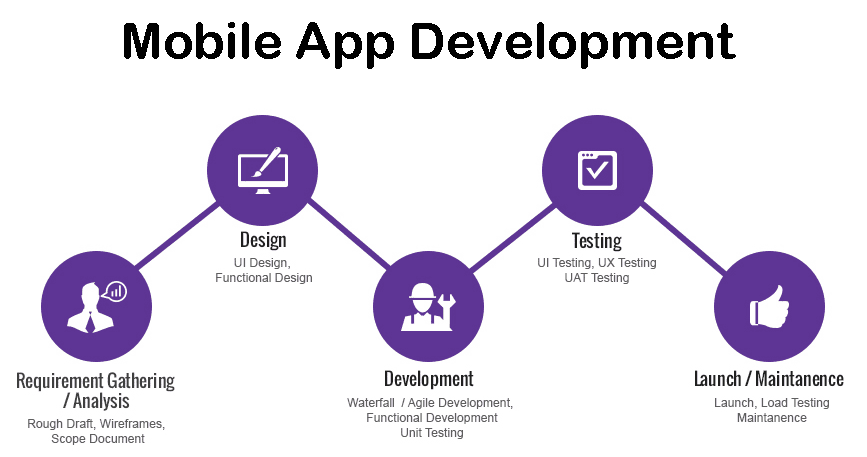Did you know the App Store has more than 1.5 million applications?
 Over the past 10 years, mobile app development has proven many promises fulfilled. Mobile apps present our conditions on mobile phones for our everyday tasks and recreation. Nowadays, numerous businesses are additionally remembering mobile application advancement for their plan of action. Because of this, the search for terms like ‘How to create an ios application,’ How to create a mobile application’ has additionally expanded on search engines.
Over the past 10 years, mobile app development has proven many promises fulfilled. Mobile apps present our conditions on mobile phones for our everyday tasks and recreation. Nowadays, numerous businesses are additionally remembering mobile application advancement for their plan of action. Because of this, the search for terms like ‘How to create an ios application,’ How to create a mobile application’ has additionally expanded on search engines.
Now the question is, why do users like ios? Firstly, it is much simpler. Secondly, app store submission is very strict to rules and maintains the quality. Thirdly, the app has made clear the privacy of the company.
iOS Application Development Process:
 Making an ios application isn’t just about making a mobile application and sending it off on the app store. The cycle requires arranging, research, appropriate abilities, and, in particular, an unmistakable concentration. To guarantee the eventual outcome’s prosperity, the mobile application improvement organization should follow a progression of steps in the application advancement cycle.
Making an ios application isn’t just about making a mobile application and sending it off on the app store. The cycle requires arranging, research, appropriate abilities, and, in particular, an unmistakable concentration. To guarantee the eventual outcome’s prosperity, the mobile application improvement organization should follow a progression of steps in the application advancement cycle.
Five main phases in the development of an application.
- Planning Phase
Before sending off an application, it is critical to have a reasonable center like what difficulties the mobile application settles, which capacities to incorporate, who is the ideal interest group, and so on.
In addition, it is fundamental for direct intensive statistical surveying to guarantee that the application is serious in your market or specialty. The arranging ease additionally remembers putting together every one of the prerequisites for the later phases of the application advancement process.
- Design Phase
In this stage, the design team presents the UI and client experience, for example, the look, feel, and route. The plan is then moved to the mobile application engineers.
- Development Phase
This stage of the application advancement process stream includes making a useful application from the current plan.
- Testing Phase
Whenever advancement is finished, it is obligatory to test the application. QA engineers survey the application to ensure it works impeccably and is liberated from errors.
- Application Release and Maintenance
When the application is tried and inspected by the client, it tends to be delivered on the market. Nonetheless, this doesn’t end the application advancement process ventures, as every application requires progressing support and should be refreshed at times to address changing client requests. So this stage just denotes the start of another advancement cycle.
How to Create an iOS Mobile App?
 The iOS application advancement work process likewise follows the typical example made sense above. Everything begins with arranging the application, trailed by planning and fostering the application, testing the item prior to sending off it, and keeping up with the application until it exists consistently.
The iOS application advancement work process likewise follows the typical example made sense above. Everything begins with arranging the application, trailed by planning and fostering the application, testing the item prior to sending off it, and keeping up with the application until it exists consistently.
However, by and by, the iOS advancement process is just difficult. iOS engineers should deal with Apple’s different designer rules to guarantee a private, safe, and easy-to-use client experience.
A detailed explanation of all the development steps of the iOS application:
- Initial Steps
Research analysis
There are north of million apps on the App Store. So the market is enormously cutthroat. To ensure your application gets some momentum and is downloaded commonly, you want to do broad statistical surveying to see what apps now exist. Then perceive how those apps work and contrast them with yours.
Compliance with app store
Furthermore, the most common way of making an iOS application likewise expects that you comply with severe Apple rules. Apple just distributes those applications that meet its plan, security, client protection, and different necessities. Also, there could be no alternate way. For this reason, all the apps on iOS have a comparative appearance without losing uniqueness, and this is the reason the majority of them are all-around good.
- Design
Concept
When the rationale behind your mobile application is clear, you want to report the plan group’s prerequisites. The group would then create wireframes and outlines that show what the application would resemble. This planning stage establishes the groundwork for the ensuing application configuration process and different strides to create an application.
UI and UX design
The basic cycle in making an application decides the client experience and what the application will resemble. At this stage, the objective is to create an outwardly engaging and simple to explore/instinctive plan. The UI and client experience of the application should likewise agree with Apple rules.
Software architecture
The other significant advance that tracks UI and UX configuration is arranging the product design. This progression is one of the vital stages in the iOS application improvement process as it addresses three parts of the Model View Controller (MVC) worldview: the information, the client, and the product. It infers all those actions required to ensure the adaptability and steadiness of the application.
- Application of the Necessary Steps
The underlying periods of the iOS application advancement process assist with setting up every one of the prerequisites and completing the application plan; the most basic period of the whole exertion starts in the improvement stage.
The advancement stage is tied in with rejuvenating the application idea. At this stage, the advancement group needs to work with three unique, however vital, pieces of the task: the backend, the API, and the front-finish of the mobile application.
API
The application programming interface (API) fills in as the connection between the front-end and the backend. API of one of the primary parts of the application development process.
Back-end development
It incorporates all server-side development, including support and activity, client account validation, accounts the executives, pop-up message administrations, outsider mix for online entertainment destinations, and customization of the client experience.
Front-end development
The front-end of an application is the side that associates straightforwardly with the client. It includes coding different plan components, for example, wireframes and mockups, reserving, and data set synchronization. An all-around created front-end will consider a smooth client experience in different screen sizes and directions.
Features to consider when developing applications for iOS
Starting off on continuing toward genuine development, it is critical to choose the proper innovation stack for your mobile application. Additionally, the decision of an appropriate it is vital for program language.
Here are some interesting points to begin the application development process.
XCode: Making a local iOS application requires XCode, Apple’s IDE (coordinated advancement climate), which imports application plans. This apparatus gives a few helpful capacities, for example, altering the source code, investigating the UI, and trading the application to the application store.
iOS programming language: Considering requirements, engineers can pick both of the two dialects, Objective C and Swift, to foster the iOS application. While Object-C is a superset of the C language, it is progressively being supplanted by Swift, Apple’s freshest programming language. Delivered in 2014, Swift runs two focuses multiple times quicker than Objective-C, as per Apple. It’s more brief, maintainable, safer, and viable than most present-day equipment drives.
Agile developments: Because of the fast changes in mobile stages, it is generally great to complete the iOS application advancement process as fast as could really be expected. To accomplish this objective, developers can settle on a lithe improvement approach whose achievement framework guarantees the opportune conveyance of value programming.
- Test and Finish
In the development phases of the specialized application, the subsequent stage is the item’s quality control test. Testing or surveying the application for iOS is a critical stage, considering the hardships in the accommodation cycle and endorsement of Apple’s application. The designer is to survey the application for upgraded execution, an ideal client experience, investigating, ideal memory use, security, and full consistence with all rules set out by Apple.
In the wake of surveying the application and guaranteeing that it won’t be dismissed, your application can be submitted to the App Store for additional consideration and endorsement. It can require a couple of days to a long time for Apple to answer and support your mobile item.
What next?
 An application gets finished with the effective arrangement of an application to the App Store. Be that as it may, truly, this cycle to make an iOS application goes on and on forever.
An application gets finished with the effective arrangement of an application to the App Store. Be that as it may, truly, this cycle to make an iOS application goes on and on forever.
The send-off of an application turns into a persistent course of application upkeep. It contains checking application utilization through application examination stages, estimating its prosperity through KPIs, fixing any practical and security messes that might emerge out of the blue, and refreshing application highlights and points of interaction in the radiance of client criticism and the iOS prerequisites and new updates.




